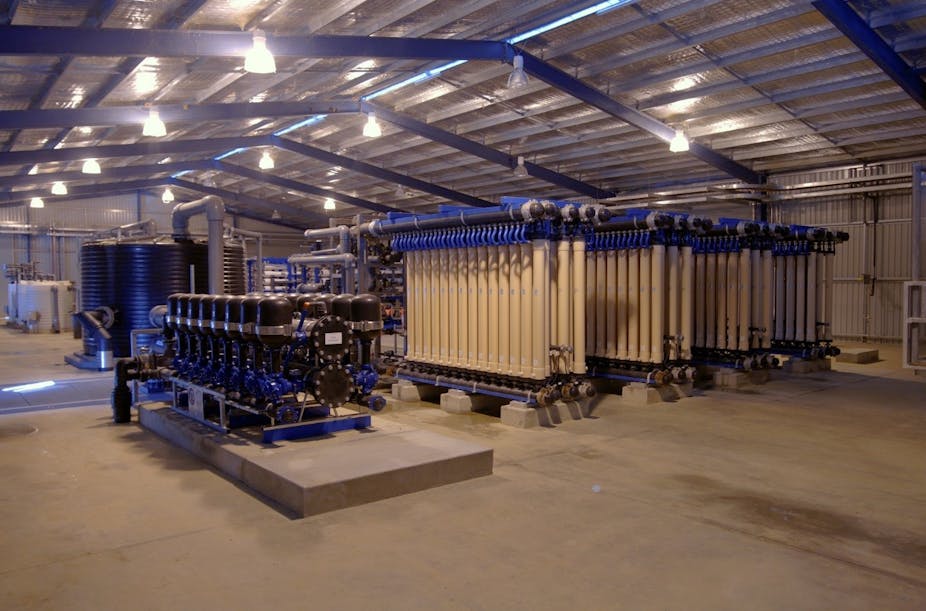One of the major concerns about coal seam gas (CSG) extraction is what to do with the water produced in the process, as well as more general concerns about the industry’s impacts on groundwater. But what if the water produced by CSG extraction could be recycled and returned to the ground?
My new research, carried out as part of CSIRO’s Gas Industry Social and Environmental Research Alliance, shows that it is possible to re-inject this CSG-produced water into aquifers, and that water quality issues should be insignificant as along as the situation is carefully monitored.
Why re-use the water from coal seam gas?
In Queensland, the state government’s policy on managing “produced water”, also commonly known as “CSG water”, is to “encourage the beneficial use of CSG water in a way that protects the environment and maximises its productive use as a valuable resource”.
The government’s policy says that CSG water should, where possible, be used to benefit one or more of the following: the environment, existing or new water users, and existing or new water-dependent industries.
If that is not possible, and once feasible beneficial uses have been considered, the regulations say that CSG water should be treated and disposed of in a way that avoids or minimises environmental damage.
CSG produced water has several possible uses, depending on its quality, quantity and level of treatment, including:
supplying local farmers and communities;
irrigation of agricultural crops or plantation forestry;
dust suppression;
industrial purposes such as drilling, coal washing, power station cooling;
replenishing weirs and dams, or restoring flows in rivers exposed to heavy irrigation demand;
recharging aquifers.
CSG companies in Queensland are therefore testing the viability and potential environmental impacts of re-injecting treated CSG produced water. This first involves treating the water to remove dissolved salts and other chemicals, after which the water quality is often better than in the target aquifers for re-injection.
A critical question is what will happen to the quantity and quality of the groundwater already in the receiving aquifer. This is the question we have tried to answer, by building on existing computer models to develop a method of predicting the local and regional impacts on water quality and quantity.
We built and integrated four models that simulate groundwater flow and how any contaminants might travel through aquifers. One of the models used was based on the regional groundwater model developed by Queensland’s Office of Groundwater Impact Assessment to study groundwater flows through the Surat Basin.
The other three, finer-scale models were built to better understand the groundwater system and impacts of re-injecting treated CSG water at varying distances from the injection well. Some of the key questions we tried to answer using these models were:
If the water quality in the aquifer changes, how far and how long would it take for the re-injected water to dilute back to the background water quality?
Are there any domestic or stock bores at risk of contamination?
How does the possible presence of geological faults influence the predictions?
The results
The model simulations of large scale re-injection of treated CSG water into the Precipice Sandstone in Surat Basin showed that an increase in groundwater pressure would occur on a regional scale. The groundwater level could increase up to a maximum of 140 m in the observation bores near the re-injection site. But the maximum increase in groundwater level in stock and domestic wells, which are located far from the re-injection site, are expected to be minimal.
For example, the nearest domestic and stock bore is around 15 km from the re-injection well site, and simulations show that the maximum groundwater level increase in this bore would be 4.3 m (some of the bores in this region are free-flowing artesian bores, meaning that water already reaches the surface under pressure from below).
This increase can occur naturally even without any re-injection, and so may not necessarily be a risk. Also, the increase in groundwater level means that availability of fresh water in this region is increased and can be drawn out over many decades. The model also illustrated that changes in groundwater levels in other aquifers overlying the Precipice sandstone would be minimal (see below).

We also used our models to identify potential changes in groundwater quality. The results showed that re-injected treated CSG water would be diluted to very low concentrations (1% or less of the original concentration) within 5 km of the injection well.
There were no domestic and stock bores located within 5 km of the injection well, this means the risk of contamination of such bores located in the Precipice Sandstone from re-injecting treated CSG water is considered insignificant.
However, given the proposed injection wells are spread over a large area and the uncertainty of mobilising contaminants already present in the formation, it will be essential to monitor continually the groundwater quality, to detect and contain any undesirable changes.
This article was co-written with Catherine Moore, Senior Groundwater Modeller, GNS Science, New Zealand.

